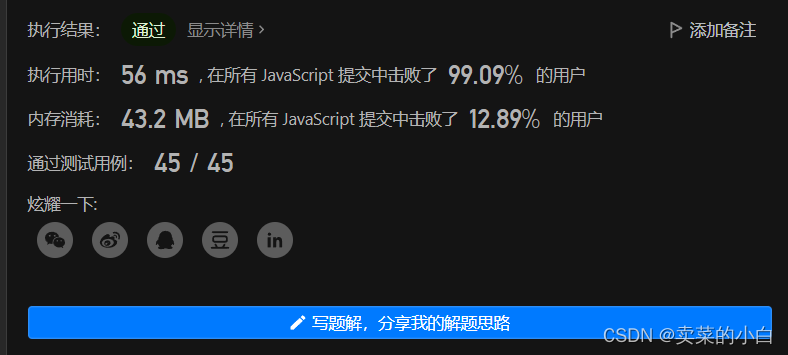一、题目
给你一个字符串 s 和一个字符串列表 wordDict 作为字典。请你判断是否可以利用字典中出现的单词拼接出 s 。
注意:不要求字典中出现的单词全部都使用,并且字典中的单词可以重复使用。
二、示例
输入: s = "leetcode", wordDict = ["leet", "code"]
输出: true
解释: 返回 true 因为 "leetcode" 可以由 "leet" 和 "code" 拼接成。
输入: s = "applepenapple", wordDict = ["apple", "pen"]
输出: true
解释: 返回 true 因为 "applepenapple" 可以由 "apple" "pen" "apple" 拼接成。
注意,你可以重复使用字典中的单词。
输入: s = "catsandog", wordDict = ["cats", "dog", "sand", "and", "cat"]
输出: false
三、思路
我们使用Set数据结构,保存字典中得全部字符串。然后使用递归。递归传入参数为字符串,如果当前的字符串为"", 则直接返回true,然后在遍历当前字符串,如果字符串前部分在set中,然后对后部分使用递归,如果后部分为true,则直接返回true。如果什么都不存在,则返回false。
四、代码
/**
* @param {string} s
* @param {string[]} wordDict
* @return {boolean}
*/
var wordBreak = function (s, wordDict) {
let set = new Set(wordDict)
const rec = (str) => {
if (str === "") return true
for(let i = 0; i < str.length; i++) {
if(set.has(str.substring(0, i + 1))) {
if(rec(str.substring(i + 1))) {
return true
}
}
}
return false
}
return rec(s)
};
上面为代码,但是结果是可以运行出来的,但是会报超时错误。

五、优化
我们要明白,为什么会超时?
例如:如果当前我们输入单词为a(20个)b,然后进行递归,首先递归的是rec(19a + b), 然后是rec(18a + b),......递归到最后。
然后开始递归rec(18a +b), rec(17a +b).....,因为上面都已经递归过了,所以任然需要再次进行计算。才会导致超时。
解决方法:
我们可以使用hash表,如果当前的不存在,则存入hash表中,如果下次我们进行递归时,碰到该字符串,此时直接返回就OK了。
六、优化后的代码
/**
* @param {string} s
* @param {string[]} wordDict
* @return {boolean}
*/
var wordBreak = function (s, wordDict) {
let set = new Set(wordDict)
let map = new Map()
const rec = (str) => {
if (str === "") return true
if(map.has(str)) return false
for(let i = 0; i < str.length; i++) {
if(set.has(str.substring(0, i + 1))) {
if(rec(str.substring(i + 1))) {
return true
}else {
map.set(str.substring(i + 1), true)
}
}
}
return false
}
return rec(s)
};
七、总结
